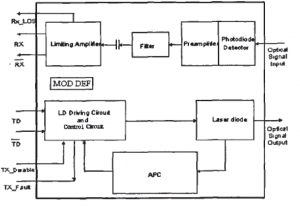2.5G SFP optical module development of high-performance general scheme
1. working principle of the module
Long-range fiber optic sfp module products for unity with APD receiver module, work rate 2500Mbps, transmission distance 80km, electrical interface can hot swap without power, dual LC optical interface plug type, with DDM digital diagnostic functions. Transmitter and receiver module is divided into two parts. LC driven in part by an integrated emission control circuit with APC and DFB-LD components. The integrated circuit receiving LVPECL logic level signal and provide for the LD bias and modulation currents, APC loop current size according to the size of the generated light emitted optical power LD, to achieve automatic control of emitted light power work can be. The integrated circuit with a transmitter shutdown; receiving section includes APD TIA components and limiting amplifier chip. CML limiter amplifier output logic level signal and a signal having a LOS alarm function.

2.5 G electric modulation signal, through TD difference data input feet enter into the light module launch part, through the module within the Laser Driver produces light modulation signal data, through the optical fiber transmission.Optical signal to receive data, through the optical module will receive part of the light signal into electrical signal modulation and shaping amplifier, in through the module of Rx difference data feet output.So as to realize the long- distance transmission of data through the optical fiber.
2. based on SFP-MSA Multi-Source Agreement design
SFP-MSA Multi-Source Agreement sets out our main design SFI 'need to meet the mechanical dimensions, package, module definition and application circuit Goldfinger peripheral module inserted row, making it compatible with a wide range in the optical communication equipment. According to the requirements of the agreement, we have designed single mode fibre sfp housing meets the requirements of the agreement.
3. Based on the design of SFF-8472 standard
SFF-8472 standard defines the main multi mode sfp digital diagnostic functions and modules to achieve the principles of internal software storage space Standard definition, making the system vendors through MOD-DEF modules (0) ~ MOD-DEF (2) of the three legs of the operating parameters of the software control module for real-time monitoring.
According to the definition of this standard, thismulti mode sfp designed to its operating voltage (reported accuracy of ± 3%), operating temperature (reported accuracy of ± 3 ℃), transmitted optical power (reported accuracy of ± 3dB), transmit bias (reported accuracy of ± 10 %), received optical power (reported accuracy of +3 dB) for real-time reporting, enabling the SFP digital diagnostic functions.
4. light-emitting device selection
Because the module work rate reached 2.5G, transmission reach 80km and small packages. So we use the LC 1550nm DFB laser with coaxial isolators as emitting device according to the design. (1) DFB device characteristics: DFB lasers belongs to a single longitudinal mode (SLM, Single LongitudinaL Mode) semiconductor lasers. Compared SLM semiconductor lasers with Fabry-Perot laser, it is no longer independent of the resonant cavity loss pattern, but different vertical mold design paired with different losses.
